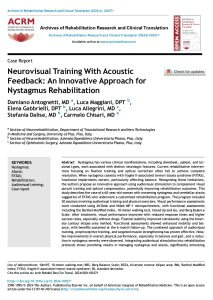New Clinical Insights into Nystagmus Treatment: AOUP’s Experience with AvDesk
A recent clinical study by Pisa University Hospital (AOUP), Italy, shows that audiovisual stimulation with AvDesk is an effective and innovative treatment for nystagmus, supported by strong clinical evidence.
A recent publication in Archives of Rehabilitation Research and Clinical Translation (December 2024)1 provides evidence supporting the effectiveness of an innovative rehabilitation protocol based on multisensory stimulation for the treatment of progressive nystagmus, implemented through the AvDesk device.
The study, titled Neurovisual Training With Acoustic Feedback: An Innovative Approach for Nystagmus Rehabilitation1, was conducted by the Neurorehabilitation Unit of the Pisa University Hospital (AOUP, Italy), under the supervision of Professor Carmelo Chisari (Head of the Unit of Physical and Rehabilitation Medicine) and Dr. Damiano Antognett, lead author of the case study.
Clinical Context of the Multisensory Approach
Nystagmus, in its various phenotypes (congenital, neurological, and vestibular), is a complex and often disabling condition, with significant repercussions on vision, balance, and mobility.
Conventional therapies provide limited and often short-lived benefits.
The neurophysiological rationale behind audiovisual stimulation, also applied in the treatment of visual deficits such as hemianopia, is supported by a broad body of international scientific evidence.
Over 19 years of publications confirm the clinical effectiveness of this approach in visual field rehabilitation and in enhancing attentional and perceptual functions.
Simultaneous exposure to appropriately modulated visual and auditory stimuli can promote neuroplasticity and reorganize the neural networks responsible for oculomotor and postural control.
This strong foundation of clinical evidence makes AvDesk a versatile and reliable tool for the treatment of nystagmus and other complex neurovisual disorders.
The AOUP Protocol: Treatment with AvDesk
The clinical study involved a 60-year-old woman with postural instability and severe oscillopsia, who underwent a cycle of 30 rehabilitation sessions. The treatment included:
- visual and auditory stimulation with AvDesk;
- proprioceptive and muscle-strengthening exercises;
- monitoring through microperimetry, Timed Up and Go (TUG), 10-Meter Walk Test (10mWT), and Berg Balance Scale.
Following the personalized treatment, multisystem improvement was observed:
- enhanced visual fixation (BCEA);
- reduced response times to visual stimuli;
- improved postural stability and walking ability;
- sustained benefits at the 6-month follow-up.
The case study suggests a stable neural adaptation and the synergistic efficacy of the multisensory approach, particularly in degenerative neurological conditions such as FXTAS.
The 6-month follow-up confirmed the maintenance of performance improvements compared to baseline, particularly in terms of success rates and response times during sessions conducted without pharmacological treatment (see Figures 1 and 2).
A Replicable Model for Clinical Practice
The work of Professor Chisari’s and Dr. Antognetti’s team provides a concrete, evidence-based model to address complex clinical cases. Audiovisual stimulation proves to be a safe, non-invasive, and customizable strategy, applicable also to other forms of nystagmus.
In particular, the results open new perspectives in nystagmus rehabilitation, including:
- adaptability of the protocol to different etiologies (vestibular, neurological, and congenital);
- integration with existing diagnostic tools (microperimetry and postural analysis);
- applicability in both hospital and outpatient settings, with supervised home-based programs.
Bring innovation to your Center
Linari Medical supports neurologists, physiatrists, orthoptists, ophthalmologists, and rehabilitation therapists in integrating advanced protocols based on AvDesk.
With our assistance, you can:
- incorporate multisensory stimulation into your clinical practice;
- receive support in device setup;
- participate in multicenter studies or experimental protocols;
- organize dedicated training programs for your team.
Request More Information
Enter your details, and we will provide you with further information about neuro-visual rehabilitation.
Bibliography
- Damiano Antognetti, Luca Maggiani, Elena Gabbrielli, Luca Allegrini, Stefania Dalise, Carmelo Chisari. Neurovisual Training With Acoustic Feedback: An Innovative Approach for Nystagmus Rehabilitation, Archives of Rehabilitation Research and Clinical Translation. Volume 6, Issue 4, 2024, 100371, ISSN 2590-1095. Doi: 10.1016/j.arrct.2024.100371.
